Predators
- Animals, Bees, Birding, Compost, Fruit, Fungus and Mushrooms, Gardening adventures, Herbs, Hugelkultur, Natives, Other Insects, Permaculture and Edible Forest Gardening Adventures, Ponds, Predators, Rain Catching, Reptiles and Amphibians, Seeds, Soil, Vegetables, Water Saving, Worms
The Mulberry Guild
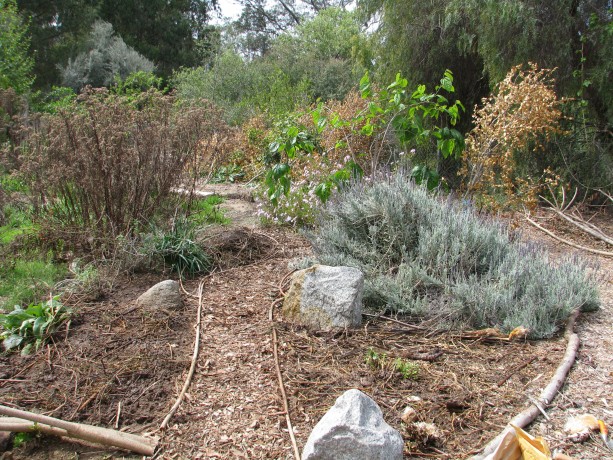
The renovated and planted mulberry guild. One of our larger guilds has a Pakistani mulberry tree that I’d planted last spring, and around it had grown tomatoes, melons, eggplant, herbs, Swiss chard, artichokes and garlic chives.
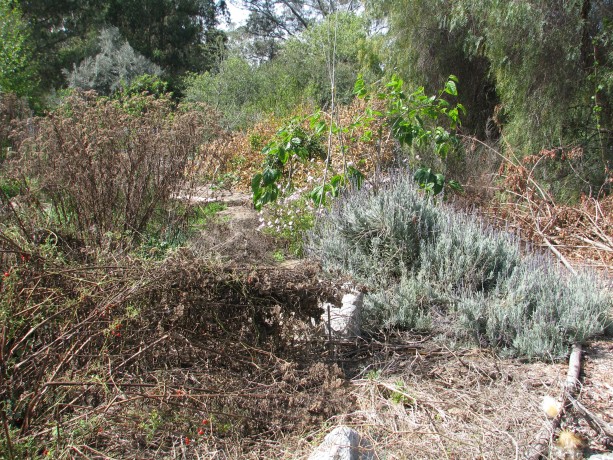
Mulberry guild with last year’s plant matter and unreachable beds. This guild was too large; any vegetable bed should be able to be reached from a pathway without having to step into the bed. Stepping on your garden soil crushes fungus and microbes, and compacts (deoxygenates) the soil. So of course when I told my daughter last week that we had to plant that guild that day, what I ended up meaning was, we were going to do a lot of digging in the heat and maybe plant the next day. Most of my projects are like this.
Lavender, valerian, lemon balm, horehound, comfrey and clumping garlic chives were still thriving in the bed. Marsh fleabane, a native, had seeded itself all around the bed and had not only protected veggies from last summer’s extreme heat, but provided trellises for the current tomatoes.
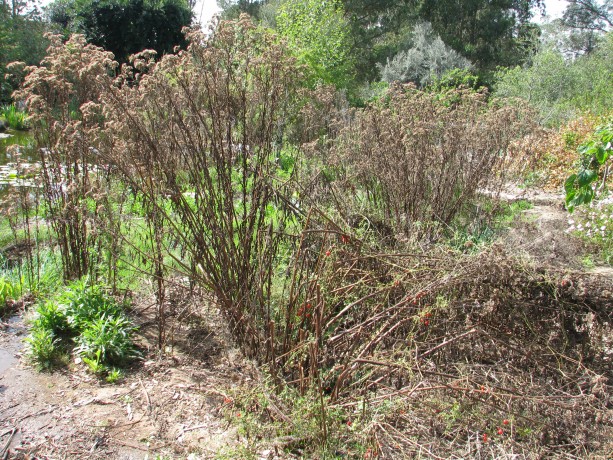
Fleabane stalks from last year, with new growth coming from the roots. Marsh fleabane is an incredible lure for hundreds of our tiny native pollinators and other beneficial insects. Lots of lacewing eggs were on it, too. The plants were coming up from the base, so we cut and dropped these dead plants to mulch the guild.
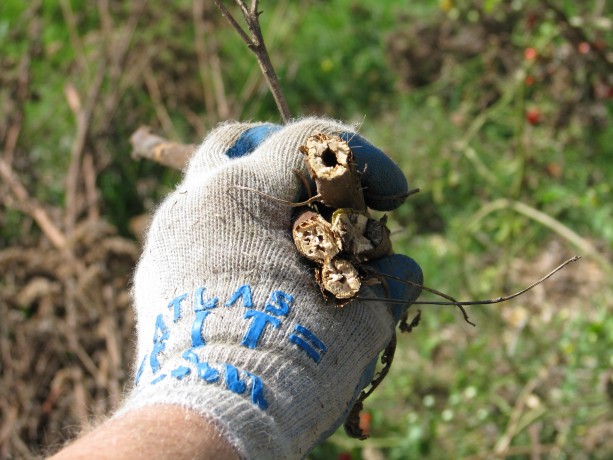
The stalks of fleabane are hollow… perfect homes for small bees! The stems were hollow and just the right size to house beneficial bees such as mason bees. This plant is certainly a boon for our first line of defense, our native insects.
We also chopped and dropped the tomato vines. Tomatoes like growing in the same place every year. With excellent soil biology – something we are still working on achieving with compost and compost teas – you don’t have to rotate any crops.

Slashed and dropped tomato and fleabane. We had also discovered in the last flood that extra water through this heavy clay area would flow down the pathway to the pond, often channeled there via gopher tunnels.
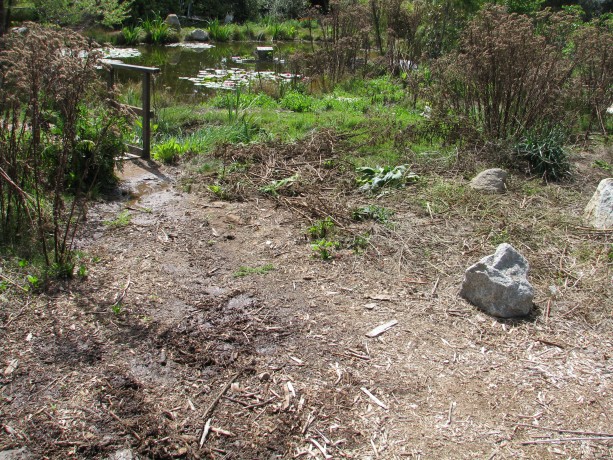
The pathway is a water channel during heavy rains. It needs fixing. We decided to harvest that water and add water harvesting pathways to the garden at the same time. We dug a swale across the pathway, perpendicular to the flow of water, and continued the swale into the garden to a small hugel bed.

Swale dug on contour through the pathway and across the guild. Hugelkultur means soil on wood, and is an excellent way to store water in the ground, add nutrients, be rid of extra woody material and sequester carbon in the soil. We wanted the bottom of the swale to be level so that water caught on the pathway would slowly travel into the bed and passively be absorbed into the surrounding soil. We used our wonderful bunyip (water level).
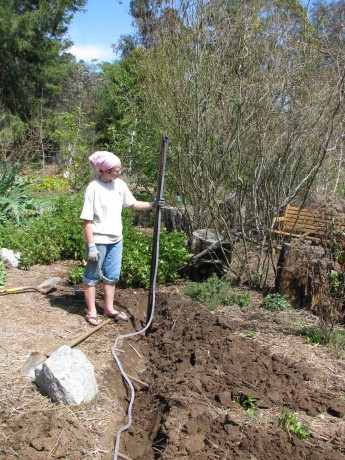
Using a bunyip to make the bottom of the swale level. Water running into the path will now be channeled through the guild. Because of the heavy clay involved we decided to fill the swale with woody material, making it a long hugel bed. Water will enter the swale in the pathway, and will still channel water but will also percolate down to prevent overflow. We needed to capture a lot of water, but didn’t want a deep swale across our pathway. By making it a hugel bed with a slight concave surface it will capture water and percolate down quickly, running along the even bottom of the swale into the garden bed, without there being a trippable hole for visitors to have to navigate. So we filled the swale with stuff. Large wood is best for hugels because they hold more water and take more time to decompose, but we have little of that here. We had some very old firewood that had been sitting on soil. The life underneath wood is wonderful; isn’t this proof of how compost works?
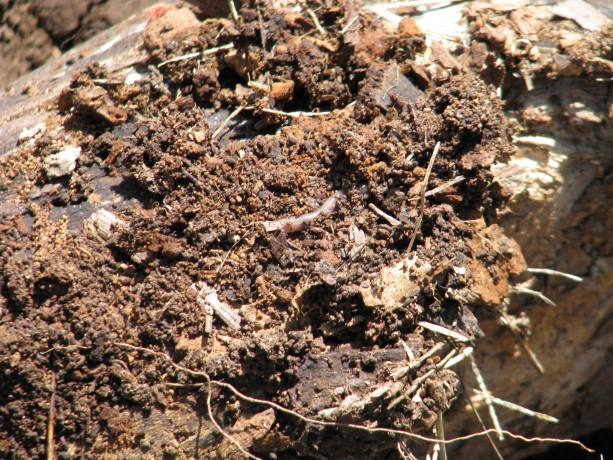
The activity under an old log shows so many visible decomposers, and there are thousands that we don’t see. We laid the wood into the trench.
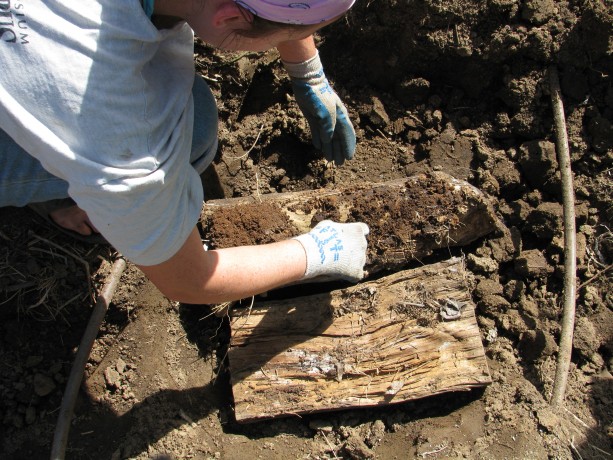
Placing old logs in the swale. If you don’t have old logs, what do you use? Everything else!
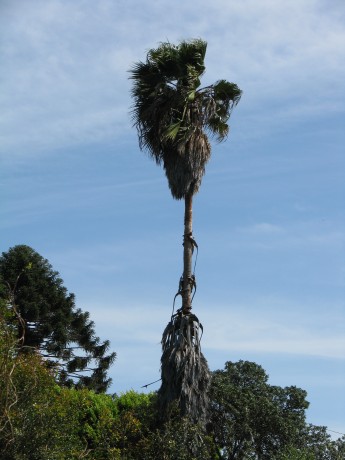
This giant palm has been a home to raccoons and orioles, and a perch for countless other birds. The last big wind storm distributed the fronds everywhere. We are wealthy in palm fronds.
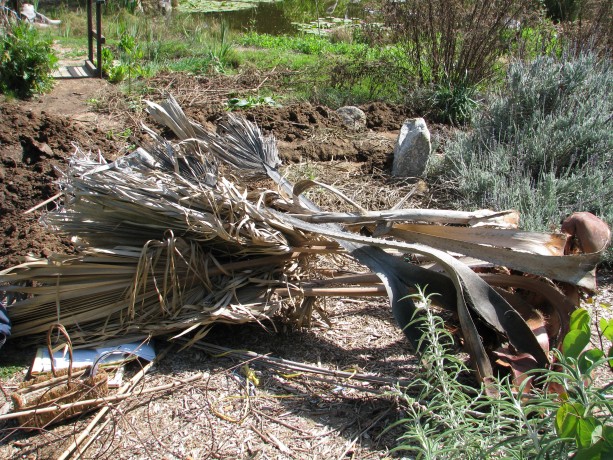
Three quick cuts (to fit the bed) made these thorny fronds perfect hugelbed components. We layered all sorts of cuttings with the clay soil, and watered it in, making sure the water flowed across the level swale.
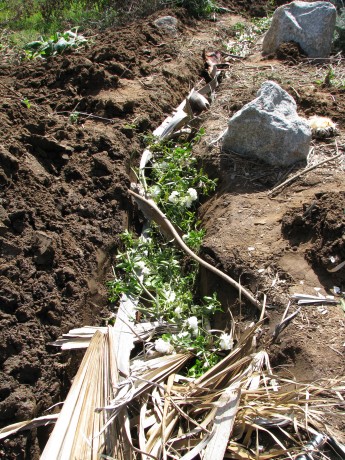
We filled the swale with fronds, rose and sage trimmings, some old firewood and sticks, and clay. As we worked, we felt as if we were being watched.
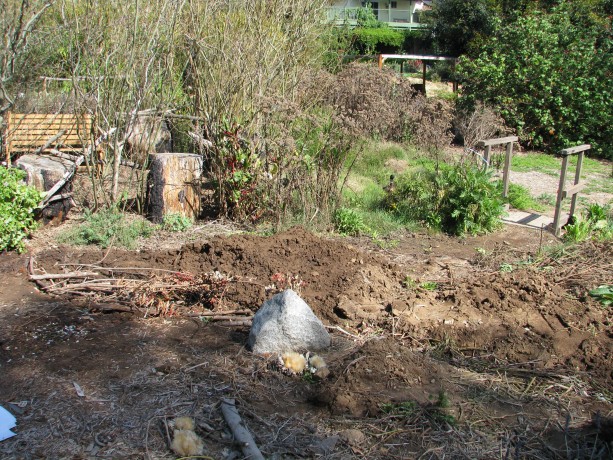
Can you spot the duck in this photo? Mr. and Mrs. Mallard were out for a graze, boldly checking out our progress. He is guarding her as she hikes around the property, leading him on a merry chase every afternoon. You can see Mr. Mallard to the left of the little bridge.
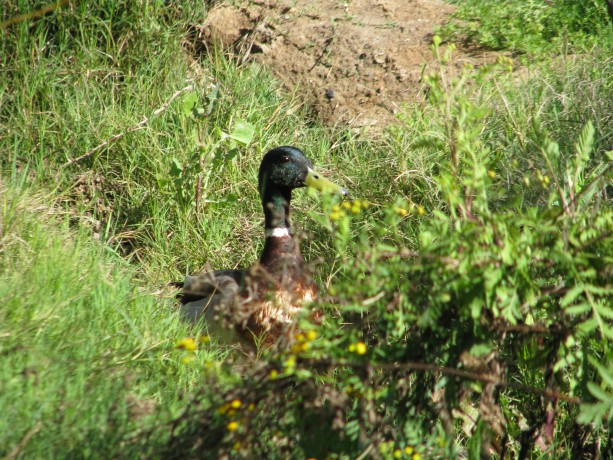
This male mallard and his mate, who is ‘ducked’ down in front of him, enjoyed grazing on weeds and watching we silly humans work so hard. After filling the swale, we covered the new trail that now transects the guild with cardboard to repress weeds.
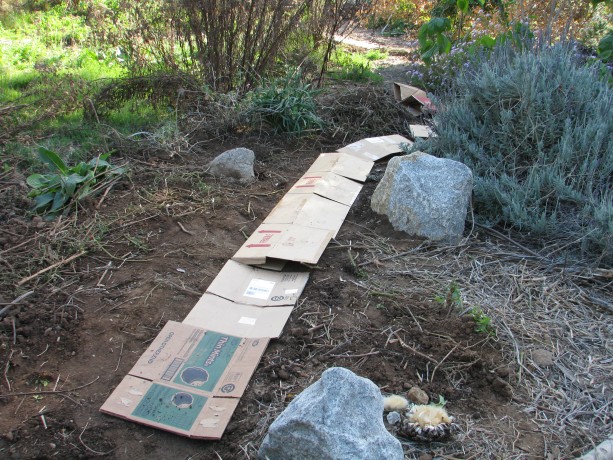
Cardboard laid over the hugelswale. Then we covered that with wood chips and delineated the pathway with sticks; visitors never seem to see the pathways and are always stepping into the guilds. Grrr!

The cardboard was covered with wood chips and the pathway delineated with sticks. Where the trail curves to the left is a small raised hugelbed to help hold back water. At this point the day – and we – were done, but a couple of days later we planted. Polyculture is the best answer to pest problems and more nutritional food. We chose different mixes of seeds for each of the quadrants, based on situation, neighbor plants, companion planting and shade. We kept in mind the ‘recipe’ for plant guilds, choosing a nitrogen-fixer, a deep tap-rooted plant, a shade plant, an insect attractor, and a trellis plant. So, for one quarter we mixed together seeds of carrot, radish, corn, a bush squash, leaf parsley and a wildflower. Another had eggplant, a short-vined melon (we’ll be building trellises for most of our larger vining plants), basil, Swiss chard, garlic, poppies, and fava beans. In the raised hugelbed I planted peas, carrots, and flower seeds.
In the back quadrant next to the mulberry I wanted to trellis tomatoes.
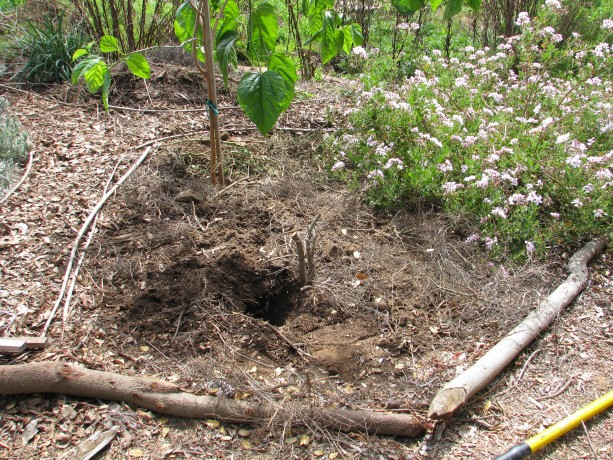
This quadrant by the mulberry needed a trellis for tomatoes. I’d coppiced some young volunteer oaks, using the trunks for mushroom inoculation, and kept the tops because they branched out and I thought maybe they’d come in handy. Sure enough, we decided to try one for a tomato trellis. Tomatoes love to vine up other plants. Some of ours made it about ten feet in the air, which made them hard to pick but gave us a lesson in vines and were amusing to regard. So we dug a hole and stuck in one of these cuttings, then hammered in stakes on either side and tied the whole thing up.
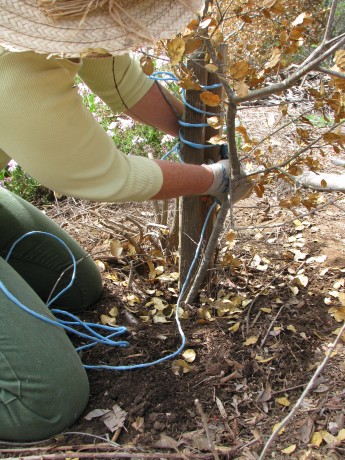
Tying the trunk to two stakes with twine taken from straw bales. Love the blue color! The result looks like a dead tree. However, the leaves will drop, providing good mulch, the tiny current tomatoes which we seeded around the trunk will enjoy the support of all the small twigs and branches, and will cascade down from the arched side.
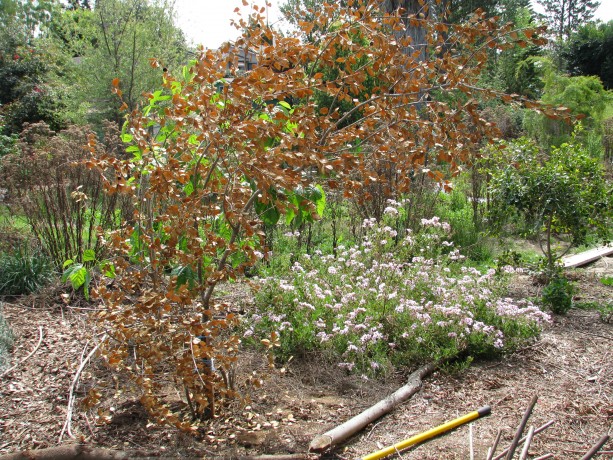
The ‘dead tree’ look won’t last long as the tomatoes climb over it and dangle close to the path for easy harvesting. We seeded the area with another kind of carrots (carrots love tomatoes!) and basil, and planted Tall Telephone beans around the mulberry trunk to use and protect it with vines. We watered it all in with well water, and can’t wait to see what pops up! We have so many new varieties from Baker Creek Heirloom Seeds and other sources that we’re planting this year! Today we move onto the next bed.
-
Coyotes
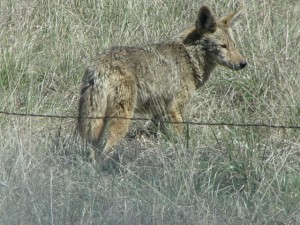
A coyote from some years back. Fall and winter are the times of year when many outdoor pets disappear. I’ve blogged on this before, too. ‘Teenaged’ coyotes, hungry (just like human teens!), bolder and less cautious will come closer to homes and people to grab food. If there is pet food outside the house, coyotes will take it if they can. If you have small pets outside, even chained, they can be killed by coyotes.
This doesn’t make coyotes evil. They are predators, a very necessary part of the food chain. Look up ‘trophic cascade’. That is how preditors in a wild environment cause prey animals to keep moving in natural patterns. Unthreatened, not only can prey animals reproduce to extremes, but also they will linger over feeding areas and eat plants down to the ground rather than trim them and move on.
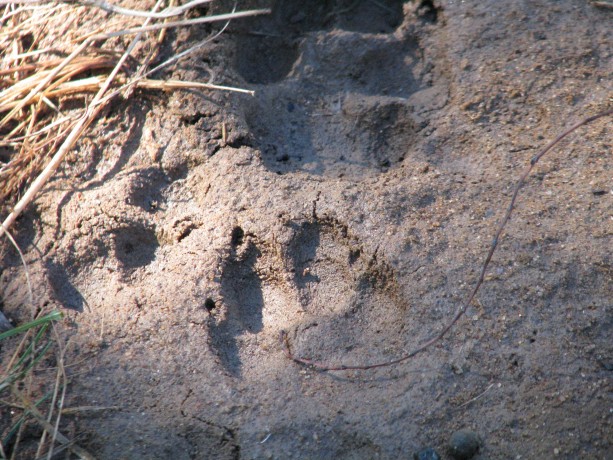
Coyote pawprints by the pond where they stopped for a drink. Dog pawprints have nails; cat (mountain lion!) pawprints don’t because their nails retract. Coyotes are intelligent, loyal, family-oriented, playful animals. They also make very scary sounds when howling and yipping in packs. Coyotes are no threat to humans unless the coyotes are sick, or if a child comes close when a coyote is eating outdoor pet food and is frightened.
Now that our last dog, Sophie, has passed away, coyotes are jumping the five-foot chainlink fence nightly and hunting in our yard. They have been unable to breach the Fowl Fortress (the hens are also locked into their coop within the FF for double protection). Unfortunately on Halloween I let the hens out of the coop about 45 minutes before dark. They had just gone under the Mock Pavilion, and I went into the FF to give Belle some of her special mash when there was a wild clucking. A coyote had come close and grabbed Chickpea our Americauna, and they were gone. My daughter saw it running away, and I dashed after, losing my slippers on the way, and hunted all over the neighbor’s yard but there was no sign of her.
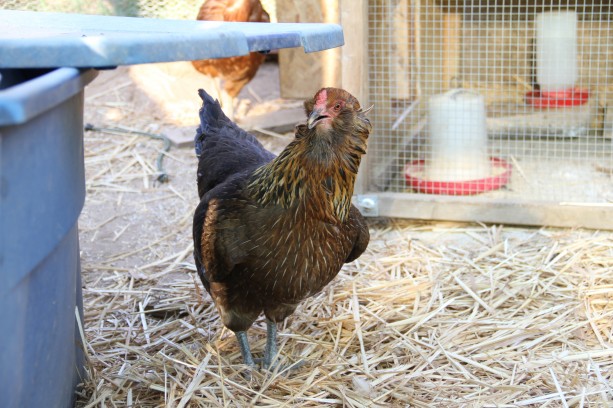
It was tramatizing, and I kick myself because I should have known better, even though I was just yards away and the hens had been released only minutes before. It was a lucky chance for the coyote, who must have already been in the yard but hidden by plants. At least it was a quick death for our darling Chickpea. It hurts us both that she is gone. No more ‘outies’ for the girls, even with a hensitter.
The coyotes leave scat in our yard and we can tell what they’ve been eating.
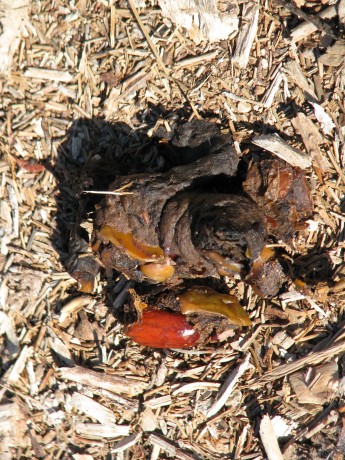
Sorry. Yes, it is coyote scat. Notice the seeds. Tiny seeds show that they were eating figs off of some volunteer fig trees down in the barranca. Larger seeds and skin in the scat shows that they are eating the red Eugenia berries in our yard. There is never much fur in the scat, so these omnivores have to scavenge to stay alive.
On the funny side, one day a few weeks ago I saw some fuzzy green thing in the yard.
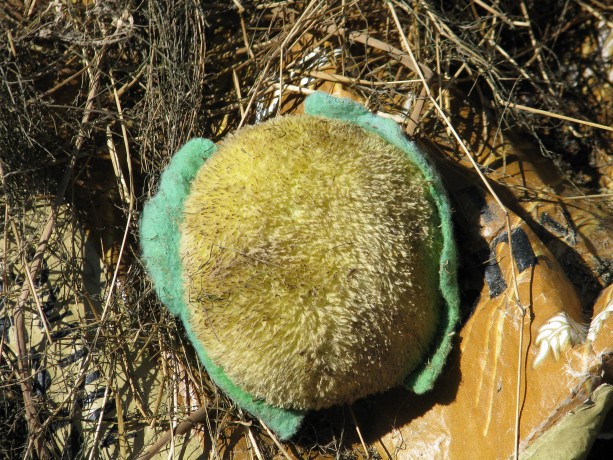
A coyote-delivered squeaky toy. It has since had its squeaker removed, and been slowly shredded by visiting coyotes. It turned out to be what looked like the center of a plush sunflower dog toy. It squeaked. It wasn’t ours. Some young coyote found it in another yard, carried it over the fence and played with it down by our pond. Over the next week it was moved around each night. One morning I found it next to a veggie bed I’d recently planted.
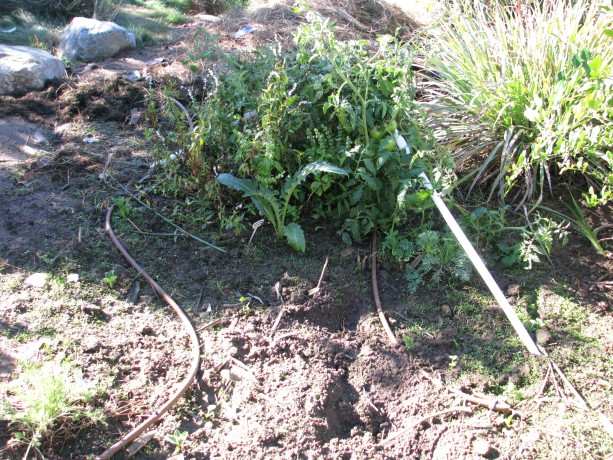
Where is my snake?? Then I realized that the rubber snake I put down in the bed to discourage birds was gone! My daughter and I looked everywhere for the snake, even for pieces of it, but it was gone! Some neighbor is going to have a real bad moment one of these days when walking through their property and they come across my rubber snake.
